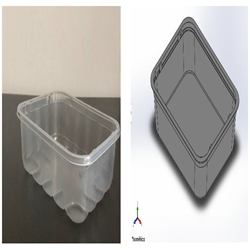Thermophysical and electrical properties of undoped and lanthanum-doped strontium titanate have been largely focusing on the final product of the final sintering temperature, thus neglecting the parallel evolution of microstructure and material properties at various intermediate sintering temperatures. Therefore, much possible essential information has been neglected, thus reducing the capabilities of producing good fundamental scientific knowledge of the microstructure-material properties, particularly in thermophysical and electrical properties.
In order to filling up the vacuum, a systematic development study from nanometric to micronic grains with parallel evolution of thermophysical and electrical properties has been elucidated. Strontium titanate, undoped and lanthanum-doped, have been prepared via the high energy ball milling and followed by sintering from 500 to 1400°C for different microstructural features.
The XRD patterns showed that an improvement of crystallinity from amorphous + crystalline mixture phases to a complete polycrystalline phase with increasing sintering temperature. The Raman spectra showed the presence of second-order features for fully-formed phase. ESR spectra revealed the paramagnetic defects existed in undoped and lanthanum-doped strontium titanate.
FESEM micrographs showed the grains evolved from 38.3nm to 2.6mm for without presintered strontium titanate and 38.0nm to 9.1mm for presintered strontium titanate. The grains size fluctuated, attributing to carbonate decomposition but become larger as sintering temperature increased from 800 to 1400°C due to the grain growth phenomenon. Doping of lanthanum has tendency to inhibit the grain growth where significant reduction of grain size (range from 34nm to 0.47mm) could be observed.
Without the presence of other leading factors such as porosity, thermal diffusivity and conductivity increased with increased grain size with the maximum value of 2.97 mm2/s and W/m.K, respectively, exhibited by the presintered strontium titanate sample. The electrical conductivity was improved with increased grain size due to reduced amount of grain boundary resistivity.
It can be concluded that the phonon scattering mechanisms and electrical transport properties were intrinsically and extrinsically influenced by several factors. Intrinsic contribution comes from the crystal structure evolving from highly amorphous to a complete polycrystalline strontium titanate. Extrinsic contributions by the microstructure, particularly from the impurities, grain boundaries, grain size, density and the porosity influenced the phonon-impurities, phonon-defects and phonon-boundaries, so also their barrier to the flow of electrons.
*Abstract of the thesis (PhD) by Idza Riati Ibrahim.
For further information please contact:
Khamirul Amin Matori, PhD
Chairman,
khamirul@upm.edu.my
Date of Input: 31/07/2023 | Updated: 31/07/2023 | roslina_ar
MEDIA SHARING























